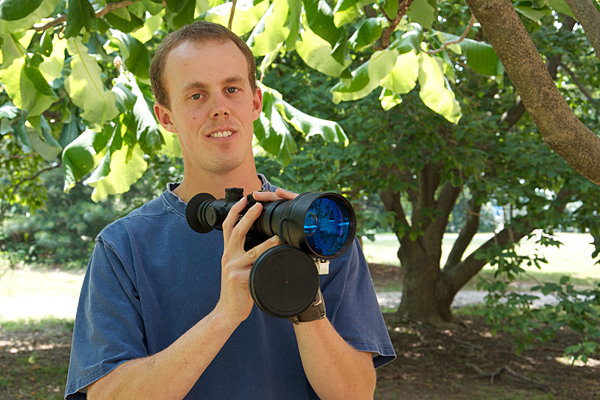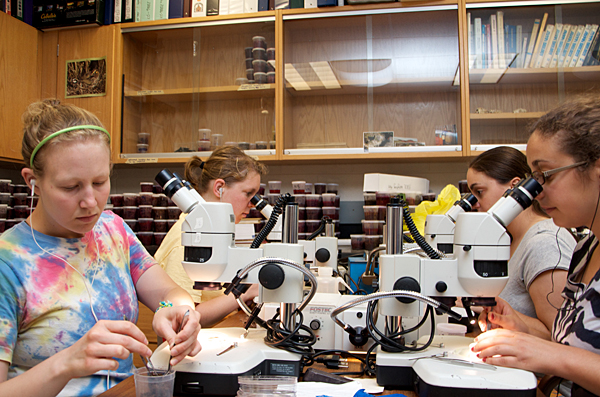


Ducks in the dark
UD wildlife biologist uses night-vision scopes to study behavior of black ducks
11:09 a.m., June 14, 2011--Chris Williams and his University of Delaware research team employ standard tools of the trade for waterfowl research – core drills for core sampling, binoculars for waterfowl viewing and lots of coffee for long stints in duck blinds. But Williams may be the first wildlife biologist to use apparatus more commonly seen on the battlefield – night-vision riflescopes.
Williams, associate professor of wildlife ecology in the College of Agriculture and Natural Resources, is studying the behavior of the American black duck to determine if there are adequate food resources on the Mid-Atlantic coast to support this dabbling duck, which has been identified as a “species of concern” by the U.S. Fish and Wildlife Service.
Research Stories
Chronic wounds
Prof. Heck's legacy
Although there’s lots of data on the daytime behaviors of the black duck, up until now no one had a good idea what it was up to at night.
“We were aware that the American black duck isn’t exclusively diurnal because of anecdotal knowledge about its nighttime calls,” says Williams. “But we didn’t know the extent of its nocturnal activities because we didn’t have the tools to study this.”
Until recently, night-vision technology wouldn’t have been up to the challenge of detecting subtle movements in the dark-colored (and aptly named) black duck, which is just 13 to 19 inches in height. But night-vision technology has improved dramatically since the military began using it extensively during the Iraq war. The latest devices can amplify light up to 50,000 times, producing clear images even on moonless nights.
It’s critical for Williams to know what black ducks do at night, as well as during the day, so he can accurately determine how much energy the birds expend. With this data, Williams and his research team will be able to establish an area’s “carrying capacity,” the number of birds a habitat can support.
“Habitat loss is a threat to the American black duck,” notes Williams. “Nationwide, black ducks have declined by as much as 60 percent. We need to understand the carrying capacity for the black duck so we can make appropriate land management decisions.”
Graduate student Orrin Jones led the field research for the project, which took place in Edwin B. Forsyth National Wildlife Refuge, six miles north of Atlantic City. American black ducks overwinter on the Jersey shore, as well as refuges and open land on Delaware’s coast, from November through March.
Field work is never a piece of cake but the black duck project could have qualified for that old reality show America’s Toughest Jobs. Jones, graduate student Jeremiah Heise (who is studying the Atlantic brant but helped with the duck research) and four technicians divvied up round-the-clock shifts, five days a week.
Because it was important to study the duck’s behaviors in a variety of habitat, from high marsh to mud flats, some study sites were only reachable by boat. After 15-minute paddles in a canoe or hour-long motor boat rides, Jones would settle in for the 9 p.m. to 3 a.m. shift and painstakingly record each time a duck swam, flew or preened. Weather ran the gamut – the infrequent mild spell, but more often, cold, rain, snow or outright blizzard conditions.
“We only missed one day of observation, during the 2010 Super Bowl blizzard, because the snow was too deep even using our 4x4 work trucks,” he says.
But for Jones field work is a piece of cake compared to what this summer holds – hour after hour inside a climate-controlled laboratory, where Williams’ research team is cataloging how much energy was available in the marsh core samples.
“I enjoy the challenges of rugged field work; it’s one of the reasons I got into avian research,” says Jones. “It’s going to be hard to be stuck inside.”
Hard but necessary. It takes about 64 hours in the lab to analyze data from each quadrant of marsh studied, estimates Williams. All told, that’s 8,000 hours of lab work for Williams’ research team.
“The American black duck was once one of the more abundant waterfowl species in eastern North America,” says Williams. “I hope this research gives us a much better understanding of the black duck’s habitat needs.”
Article by Margo McDonough
Photos by Danielle Quigley









